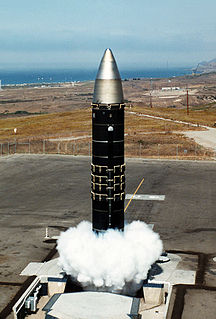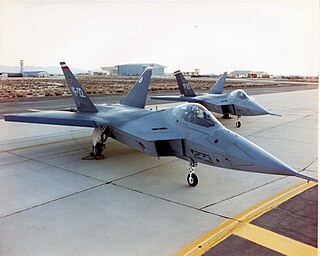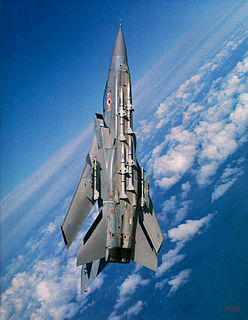
The Boeing E-3 Sentry is an American airborne early warning and control (AEW&C) aircraft developed by Boeing. E-3s are commonly known as AWACS. Derived from the Boeing 707 airliner, it provides all-weather surveillance, command, control, and communications, and is used by the United States Air Force, NATO, French Air and Space Force, and Royal Saudi Air Force. The E-3 is distinguished by the distinctive rotating radar dome (rotodome) above the fuselage. Production ended in 1992 after 68 aircraft had been built.

The Northrop Grumman E-8 Joint Surveillance Target Attack Radar System is a United States Air Force airborne ground surveillance, battle management and command and control aircraft. It tracks ground vehicles and some aircraft, collects imagery, and relays tactical pictures to ground and air theater commanders. The aircraft is operated by both active duty U.S. Air Force and Air National Guard units and also carries specially trained U.S. Army personnel as additional flight crew.

The XM2001 Crusader was to be the United States Army's next-generation self-propelled howitzer (SPH), designed to improve the survivability, lethality, mobility, and effectiveness of the artillery as well as the overall force. It was initially scheduled for fielding by 2008. United Defense was the prime contractor; General Dynamics the major subcontractor. In early May 2002, Secretary of Defense Donald Rumsfeld cancelled the US$11 billion program because he considered it neither mobile nor precise enough. The prototype SPH vehicle is on display at the cannon park at Fort Sill.

The LGM-118 Peacekeeper, originally known as the MX for "Missile, Experimental", was a MIRV-capable intercontinental ballistic missile (ICBM) produced and deployed by the United States from 1985 to 2005. The missile could carry up to 12 Mk.21 reentry vehicles, although treaty-limited to 10, each armed with a 300-kiloton W87 warhead. Initially, 100 MX ICBMs were planned to be built and deployed, but budgetary concerns eliminated the final procurement and only 50 entered service. Disarmament treaties signed after the Peacekeeper's development concluded in its eventual withdrawal from service in 2005.

The Cheyenne Mountain Complex is a Space Force installation and defensive bunker located in unincorporated El Paso County, Colorado, next to the city of Colorado Springs, at the Cheyenne Mountain Space Force Station, which hosts the activities of several tenant units. Also located in Colorado Springs is Peterson Space Force Base, where the North American Aerospace Defense Command (NORAD) and United States Northern Command (USNORTHCOM) headquarters are located.

PAVE PAWS is a complex Cold War early warning radar and computer system developed in 1980 to "detect and characterize a sea-launched ballistic missile attack against the United States". With the first solid-state phased array deployed, the system used a pair of Raytheon AN/FPS-115 phased array radar sets at each site to cover a wide azimuth angle of 240 degrees. Two sites were deployed in 1980 at the periphery of the contiguous United States, then two more in 1987–95, as part of the United States Space Surveillance Network. One system was sold to Taiwan and is still in service.

The Northrop X-4 Bantam was a prototype small twinjet aircraft manufactured by Northrop Corporation in 1948. It had no horizontal tail surfaces, depending instead on combined elevator and aileron control surfaces for control in pitch and roll attitudes, almost exactly in the manner of the similar-format, rocket-powered Messerschmitt Me 163 of Nazi Germany's Luftwaffe. Some aerodynamicists had proposed that eliminating the horizontal tail would also do away with stability problems at fast speeds resulting from the interaction of supersonic shock waves from the wings and the horizontal stabilizers. The idea had merit, but the flight control systems of that time prevented the X-4 from achieving any success.

The McDonnell Douglas/General Dynamics A-12 Avenger II was a proposed American attack aircraft from McDonnell Douglas and General Dynamics. It was to be an all-weather, carrier-based stealth bomber replacement for the Grumman A-6 Intruder in the United States Navy and Marine Corps. Its Avenger II name was taken from the Grumman TBF Avenger of World War II.

The RCA 474L Ballistic Missile Early Warning System was a United States Air Force Cold War early warning radar, computer, and communications system, for ballistic missile detection. The network of twelve radars, which was constructed beginning in 1958 and became operational in 1961, was built to detect a "mass ballistic missile attack launched on northern approaches [for] 15 to 25 minutes' warning time" also provided Project Space Track satellite data.

The Defense Support Program (DSP) is a program of the United States Space Force that operated the reconnaissance satellites which form the principal component of the Satellite Early Warning System used by the United States.

The Space-Based Infrared System (SBIRS) is a United States Space Force system intended to meet the United States' infrared space surveillance needs through the first two to three decades of the 21st century. The SBIRS program is designed to provide key capabilities in the areas of missile warning, missile defense and battlespace characterization via satellites in geosynchronous Earth orbit (GEO), sensors hosted on satellites in highly elliptical orbit (HEO), and ground-based data processing and control.

The Aermacchi M-346 Master is a family of military twin-engine transonic advanced jet trainers and light combat aircraft. Originally co-developed with Yakovlev as the Yak/AEM-130, the partnership was dissolved in 2000 and the then Alenia Aermacchi proceeded to separately develop the M-346 Master, while Yakolev continued work on the Yakovlev Yak-130. The first flight of the M-346 was performed in 2004. The type is currently operated by the air forces of Italy, Israel, Singapore, and Poland. Since 2016 the manufacturer became Leonardo-Finmeccanica as Alenia Aermacchi merged into the new Finmeccanica, finally rebranded as Leonardo in 2017.

The Air Force Systems Command (AFSC) is an inactive United States Air Force Major Command. It was established in April 1951, being split off from Air Materiel Command. The mission of AFSC was Research and Development for new weapons systems.

Greenville Downtown Airport is an airport three miles east of Greenville, South Carolina, United States. It is owned by the Greenville Airport Commission and is the busiest general aviation airport in South Carolina.
Roy Rosenzweig Center for History and New Media (RRCHNM), formerly the Center for History and New Media (CHNM) is a research center specializing in history and information technology at George Mason University (GMU) in Fairfax County, Virginia. It was one of the first digital history centers in the world, established by Roy Rosenzweig in 1994 to use digital media and information technology to democratize history: to incorporate multiple voices, reach diverse audiences, and encourage popular participation in presenting and preserving the past. Its current director is T. Mills Kelly.

The Royal Australian Air Force (RAAF) operated 24 McDonnell Douglas F-4E Phantom II fighter-bomber aircraft in the ground attack role between 1970 and 1973. The Phantoms were leased from the United States Air Force (USAF) as an interim measure owing to delays in the delivery of the RAAF's 24 General Dynamics F-111C bombers. The F-4Es were considered successful in this role, but the government did not agree to a proposal from the RAAF to retain the aircraft after the F-111s entered service in 1973.

The ITT 465L Strategic Air Command Control System was a Cold War "Big L" network of computer and communication systems for command and control of Strategic Air Command "combat aircraft, refueling tankers, [and] ballistic missiles". International Telephone and Telegraph was the prime contractor for Project 465, and SACCS had "Cross Tell Links" between command posts at Offutt AFB, March AFB, & Barksdale AFB (SACCS also communicated with the Cheyenne Mountain Complex and Air Force command posts. The 465L System included IBM AN/FSQ-31 SAC Data Processing Systems, Remote and Simplex Remote Communication Systems, SAC Network Control Office, "4-wire, Schedule 4, Type 4B alternate voice-data operation", and one-way communication with "ICBM launch control centers" In addition to IBM for the "Super SAGE type computers", another of the 6 direct subcontractors was AT&T,

Harry Leslie Van Trees is a scientist specializing in radar, sonar, communications and signal processing.
GPS Block IIIF, or GPS III Follow On , is the second set of GPS Block III satellites, consisting of up to 22 space vehicles. The United States Air Force began the GPS Block IIIF acquisition effort in 2016. On 14 September 2018, a manufacturing contract with options worth up to $7.2 billion was awarded to Lockheed Martin. The 22 satellites in Block IIIF are projected to be delivered starting in 2026, with launches estimated to last through at least 2034.

The Improved United Kingdom Air Defence Ground Environment, normally shortened to either UKADGE or IUKADGE, was the Royal Air Force's (RAF) ground-controlled interception system covering the British Isles during the 1990s. It consisted of a number of ground-based radar sites, links to airborne early warning aircraft and Royal Navy ships, a telecommunications system to send digital data and voice communications on a protected network, and processing systems based on VAX-11/780 computers. The network ultimately contained a dozen long-range radars including four Marconi Martello, two General Electric TPS-592, and six Plessey AR-320.

















